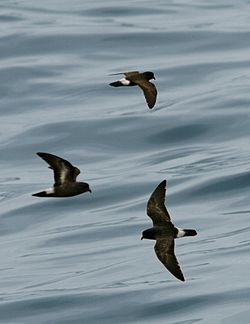

Storm petrel or stormy petrel may refer to one of two bird families, both in the order Procellariiformes, once treated as the same family.
Up and down!—up and down!
From the base of the wave to the billow's crown,
And amidst the flashing and feathery foam
The stormy petrel finds a home,—
A home, if such a place may be
For her who lives on the wide, wide sea.
O’er the deep!—o'er the deep!
Where the whale and the shark and the sword-fish sleep,—
Outflying the blast and the driving rain,
The petrel telleth her tale—in vain!
From "The Stormy Petrel", a poem by Barry Cornwall [1]
The two families are:
- Northern storm petrels (Hydrobatidae) are found in the Northern Hemisphere, although some species around the Equator dip into the south.
| Common name | Scientific name | Status |
|---|---|---|
| European storm petrel | Hydrobates pelagicus | LC |
| Fork-tailed storm petrel | Hydrobates furcatus | LC |
| Ringed storm petrel | Hydrobates hornbyi | NT |
| Leach's storm petrel | Hydrobates leucorhous | LC |
| Townsend's storm petrel | Hydrobates socorroensis | EN |
| Ainley's storm petrel | Hydrobates cheimomnestes | VU |
| Swinhoe's storm petrel | Hydrobates monorhis | NT |
| Ashy storm petrel | Hydrobates homochroa | EN |
| Band-rumped storm petrel | Hydrobates castro | LC |
| Monteiro's storm petrel | Hydrobates monteiroi | VU |
| Cape Verde storm petrel | Hydrobates jabejabe | LC |
| Wedge-rumped storm petrel | Hydrobates tethys | LC |
| Black storm petrel | Hydrobates melania | LC |
| Guadalupe storm petrel | Hydrobates macrodactylus | CR (Probably Extinct) |
| Markham's storm petrel | Hydrobates markhami | NT |
| Matsudaira's storm petrel | Hydrobates matsudairae | VU |
| Tristram's storm petrel | Hydrobates tristrami | LC |
| Least storm petrel | Hydrobates microsoma | LC |
- Southern storm petrels (Oceanitidae) are found in all oceans, although only white-faced storm petrel (breeding in the North Atlantic, in addition to the Southern Ocean) and Wilson's storm petrels (on migration) are found in the Northern Hemisphere.
| Common name | Scientific name | Status |
|---|---|---|
| Wilson's storm petrel | Oceanites oceanicus | LC |
| Pincoya storm petrel | Oceanites pincoyae | DD |
| Elliot's storm petrel | Oceanites gracilis | DD |
| Grey-backed storm petrel | Garrodia nereis | LC |
| White-faced storm petrel | Pelagodroma marina | LC |
| White-bellied storm petrel | Fregetta grallaria | LC |
| New Zealand storm petrel | Fregetta maoriana | CR |
| Black-bellied storm petrel or Gould's storm petrel | Fregetta tropica | LC |
| Polynesian storm petrel (including white-throated storm petrel) | Nesofregetta fuliginosa | EN |